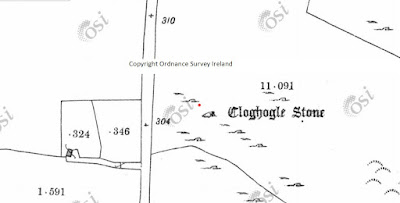Friday 31 March 2023
Scregg Sheela na Gigs, Roscommon
Scregg Passage Tomb, Roscommon
Scregg Passage Tomb Roscommon
"It's not Galway".
Wednesday 15 March 2023
Oculists, Baronets and Coffin Carts.
Recent circumstances meant I found myself for a short while at Mount Jerome Cemetery in Dublin.
Because of the circumstances I didn't do my usual wandering around however I immediately noticed the burial place of the father of Playwright and Poet Oscar Wilde, one Sir William Wilde.
Often the departed escape this earthly realm and leave us a detailed and exhaustive list of their many works of greatness, altruism and philanthropy. Note to self, perhaps I should do better.
However this can be a good thing as it makes for interesting reading on gravestones and memorial and familial armorial plaques etc.
It would appear William was made a Surgeon Oculist to Queen Victoria (I assume if ever she needed to see an eye Doctor while perambulating around Ireland then William was her man), was a Chevalier of the Royal Swedish Order of the North Star and was also the author of many illustrated works on the history and antiquities of Ireland.
He also founded a hospital at some stage when he managed to get a spare moment and wasn't busy being rather brilliant at other things. Am I jealous? You bet.
Anyway, I was shown also to the resting place of Baronet Sir Richard John Griffith, an architect who is best remembered by us non architect types as being responsible for "Griffiths Valuation". Apparently there is a Laois connection there by way of part of his education taking place at Portarlington. Where in Portarlington I have no idea.
Finally on a somewhat morbid tone I noticed a very interesting antiquity outside a nearby building. Not being 100% sure what to call it I will describe it as a Coffin Cart. It immediately brought to mind a Monthy Python "bring out yer dead" moment. I had never seen one of these before so that was a first for me.
Mount Jerome would be a very interesting place to have a wander if you are ever in the area. I think there is a Jewish Cemetery nearby too.
Keep the wheels turning.
.jpg)
.jpg)
.jpg)
.jpg)
.jpg)
.jpg)
.jpg)
.jpg)
.jpg)
.jpg)
.jpg)
.jpg)
.jpg)
.jpg)

.jpg)
.jpg)
.jpg)
.jpg)
.jpg)
.jpg)
.jpg)
.jpg)
.jpg)
.jpg)
.jpg)

.jpg)
.jpg)
.jpg)
or%20Griffiths%20Valuation_Mount%20Jerome%20Cemetery_Dublin%20(3).jpg)
or%20Griffiths%20Valuation_Mount%20Jerome%20Cemetery_Dublin%20(2).jpg)
or%20Griffiths%20Valuation_Mount%20Jerome%20Cemetery_Dublin%20(4).jpg)
.jpg)
.jpg)
.jpg)
or%20Griffiths%20Valuation_Mount%20Jerome%20Cemetery_Dublin%20(1).jpg)
or%20Griffiths%20Valuation_Mount%20Jerome%20Cemetery_Dublin%20(5).jpg)